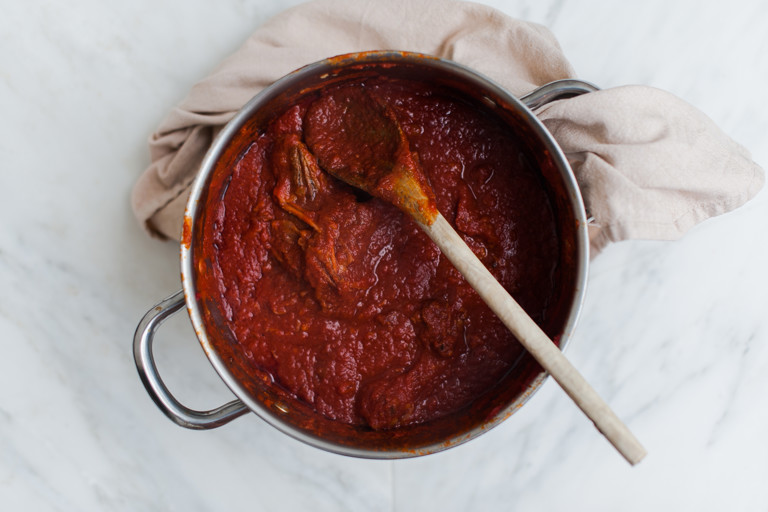Ragù Napoletano
- medium
- 6
- 8 hours
Ragù Napoletano is one of the great dishes of Campania, and perhaps encapsulates the spirit of Italian cooking better than any other. It takes time and love to prepare, with various cuts of meat carefully prepared in different ways before cooking in a rich tomato sauce for many, many hours, kept at the perfect, barely bubbling temperature. While we might associate meat ragùs with pasta alone, this ragù is designed to provide a multi-course meal in itself, with the sauce used to dressed pasta for primo, and the meat saved for slicing and serving as your secondo.
In its essence, Neapolitan ragù is a meat and tomato sauce cooked over a very low flame for a long time. Unlike ragù alla Bolognese, Neapolitan ragù is started without a battuto (the combination of carrot, onion and celery at the start of many Italian dishes); includes copious amounts of tomato sauce; and uses whole cuts rather than chopped or ground meat.
Different schools of thought exist when it comes to the types of meat used in the ragù. As with most regional Italian dishes, there are as many recipes as there are cooks. Some use a cut of beef called locena – a steak-like cut obtained from the beef chuck. Others only use pork, in the form of bone-in chops and/or ribs. Many agree that a combination of beef and pork produces the best results in terms of texture and flavour. When using beef, the meat is often flattened, seasoned with parsley, garlic, pine nuts, raisins, and cheese, and finally rolled and tied before being added to the sauce. Either way, the sauce kicks off with a soffritto made of minced fatty meats – prosciutto and pancetta, with a little piperna (a local aromatic herb similar to thyme) for an added aromatic boost.
After all the ingredients are in, the ragù has to cook over a very low heat for many hours in order to achieve its signature texture and complexity of flavour. The sauce shouldn’t be simmering; rather, it should be forming the smallest and most sporadic of bubbles – often just one lone, tiny bubble breaking the surface of the sauce every few seconds or so … not unlike an underground volcanic mud bath found in some thermal locations. (The Neapolitan term for it is peppiare.) To achieve this, first cook the sauce over a very low flame. The other way – tried and tested by many a local cook – to achieve this kind of subtle bubbling is to set the lid on top of a wooden spoon resting across the length of the pot. This way, the lid doesn’t cover the pot completely, allowing for some of the steam to escape.
The only way to tell when it’s time to turn off the heat is by using your senses – by monitoring the evolution of the sauce over time. Generally speaking, the ragù is ready when the oils and the tomato have separated and have been cooking separately for about one hour.
Because of the lengthy and somewhat laborious preparation, it could be easier to prepare the ragù a day or two ahead, then reheat it right before serving. In fact, the resting time does it some good, enabling the flavours to mingle and get acquainted, gaining in depth and complexity.
Use the sauce to season a pot of pasta (ziti or maccheroni), then serve the rest of the meat as a secondo, with some of its sauce for good measure, alongside some stir-fried greens (friarielli, to keep it traditional, or cime di rapa). Alternatively, you can use the sauce to dress a dish of lasagne di carnevale (this, as an unorthodox yet perfectly delicious replacement for the all-pork ragù it normally calls for).
Ingredients
Metric
Imperial
- 100g of prosciutto crudo, choose fine slices with plenty of fat
- 50g of pancetta, in fine slices
- 2 sprigs of thyme
- 1.5kg beef chuck
- 50g of pine nuts, finely chopped
- 50g of raisins, finely chopped
- 1 bunch of flat-leaf parsley, finely chopped
- 2 garlic cloves, minced
- 100g of young Pecorino cheese, diced
- 1kg blade steaks, flattened
- 100g of lard
- 200ml of extra virgin olive oil
- 50g of lardo, minced
- 600g of yellow onions, peeled and finely diced
- 400g of pork ribs, choose nice meaty ribs
- 300ml of dry red wine
- 250g of tomato concentrate
- 1.5l passata
- sea salt
- black pepper
Equipment
- Butcher's string
Method
- 100g of prosciutto crudo, thinly sliced
- 50g of pancetta, thinly sliced
- 2 sprigs of thyme
- 1.5kg chuck steak
- 1kg beef blade, flattened
- 50g of pine nuts, finely chopped
- 50g of raisins, finely chopped
- 1 bunch of parsley, finely chopped
- 2 garlic cloves, minced
- 100g of young Pecorino cheese, diced
- 400g of pork ribs
- 300ml of red wine
- 1.5l passata
- 250g of tomato concentrate
Get in touch
Please sign in or register to send a comment to Great British Chefs.


